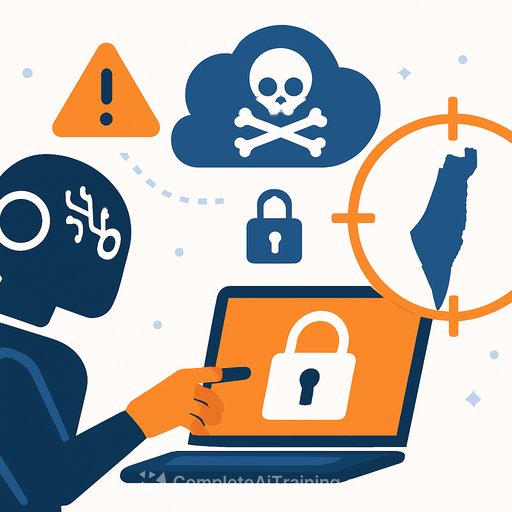AI-Driven Attacks Will Be Fully Operational by 2026. Ops Teams Need a Plan Now
Google Cloud Security warns that AI in cyberattacks is shifting from experiments to full-scale operations by 2026. AI won't sit on the sidelines-it will automate reconnaissance, write convincing phishing at volume, and generate synthetic audio and video that looks real enough to trust.
The takeaway for operations: the attack surface just got faster, cheaper, and more scalable for adversaries. This impacts incident response, fraud workflows, vendor management, customer support, and executive communications-immediately.
What's Changing
- Automated recon: AI scrapes org charts, vendor lists, and public posts to map who to target and how.
- Precision phishing at scale: highly personalized emails, chats, and texts that blend company tone, slang, and current projects.
- Deepfake audio/video: cloned voices and realistic clips used for fraud, social engineering, and disinformation.
- Coordinated influence: networks of synthetic accounts steer narratives and erode trust in official comms.
- State-aligned adoption: activity linked to Iran and others is leveraging AI content during periods of regional tension.
Google's analysts describe a shift from isolated demos to AI embedded directly in the attack chain-end to end.
Why Israel Should Pay Attention
Radware ranks Israel as the second most attacked country globally, which makes this shift more than a headline-it's an operational reality. The techniques in the report mirror patterns seen in Iran-linked influence operations targeting regional audiences.
As tools get easier to use, deepfakes and coordinated campaigns will hit call centers, finance teams, and executive assistants first-where speed and trust matter most.
What Experts Are Seeing Already
Omer Bachar, co-founder and CEO of Vetric, says the move from experiments to real deployments is already visible: "Threat actors are now using AI to increase speed, accuracy, and scale across social engineering, identity spoofing, and coordinated influence campaigns. This is real offensive automation in the wild."
Operational Risks You'll See on the Ground
- Voice-based fraud: cloned voices requesting urgent transfers, password resets, or gift card purchases.
- Executive and vendor impersonation: AI-written emails that mirror tone, context, and formatting.
- Customer support overload: scams that weaponize help desks with falsified media "proof."
- Procurement abuse: fake vendors, spoofed domains, and invoice redirects with convincing documents.
- Incident confusion: synthetic clips circulating during crises to derail response and public messaging.
- Recon at scale: AI agents mine LinkedIn, GitHub, and press releases to craft specific lures.
15-Day Action Plan for Operations
- Day 1-3: Lock down identity. Enforce phishing-resistant MFA (FIDO2) for finance, execs, IT, and support. Disable SMS-based fallback for high-risk users.
- Day 3-5: Validate communications. Create a "no exceptions" callback rule and passphrase for money movement, sensitive data requests, and account changes.
- Day 5-7: Email and domain hygiene. Set DMARC to quarantine or reject. Tighten SPF/DKIM. Monitor lookalike domains.
- Day 7-9: Vendor verification. Add a second-channel verification step for banking changes and contract updates. Log every exception.
- Day 9-11: Deepfake-aware training. Teach frontline teams to spot audio latency, unnatural cadence, and "urgent secrecy" scripts. Keep it scenario-based.
- Day 11-13: Crisis comms playbook. Pre-approve channels, spokespeople, and a 3-step "verify, acknowledge, publish" workflow when fake media circulates.
- Day 13-15: Instrumentation. Track KPIs: BEC attempts caught, vendor changes verified, ticket spoof rate, and time-to-verify for high-risk requests.
Controls to Implement This Quarter
- Money movement guardrails: dual approval, mandatory hold times on new beneficiaries, and out-of-band verification.
- Media provenance checks: adopt C2PA/Content Credentials where possible; flag unverified media in internal channels.
- Account integrity: geo-velocity checks, impossible travel, session anomaly alerts, and adaptive risk-based challenges.
- Access boundaries: least privilege for finance and IT admin roles; break-glass accounts with hardware keys only.
- Public-facing safeguards: stricter social media account controls, verified badges where available, and takedown playbooks for impersonation.
- Detection content: rules for AI-written lure patterns, lookalike domains, and unusual vendor update frequency.
- Third-party risk: require secure email configs, MFA, and change-control evidence from critical vendors.
How to Brief Leadership
- Show two scenarios: a voice-cloned CFO wire request and a fake "breaking news" clip during an outage.
- Quantify exposure: number of users who can move funds, current DMARC policy, and vendor change frequency.
- Ask for specific approvals: FIDO2 keys for high-risk users, a verification SLA, and budget for domain monitoring and takedown services.
Recommended References
Upskill Your Team
Train frontline staff to handle AI-driven social engineering and verification workflows. If you need a curated track for roles across your org, see the courses by job catalog.
AI is closing the gap between test and deployment. Treat it like a live-fire exercise: tighten identity, codify verification, instrument your comms, and rehearse under time pressure. Speed, clarity, and discipline are your advantage.
Your membership also unlocks:





